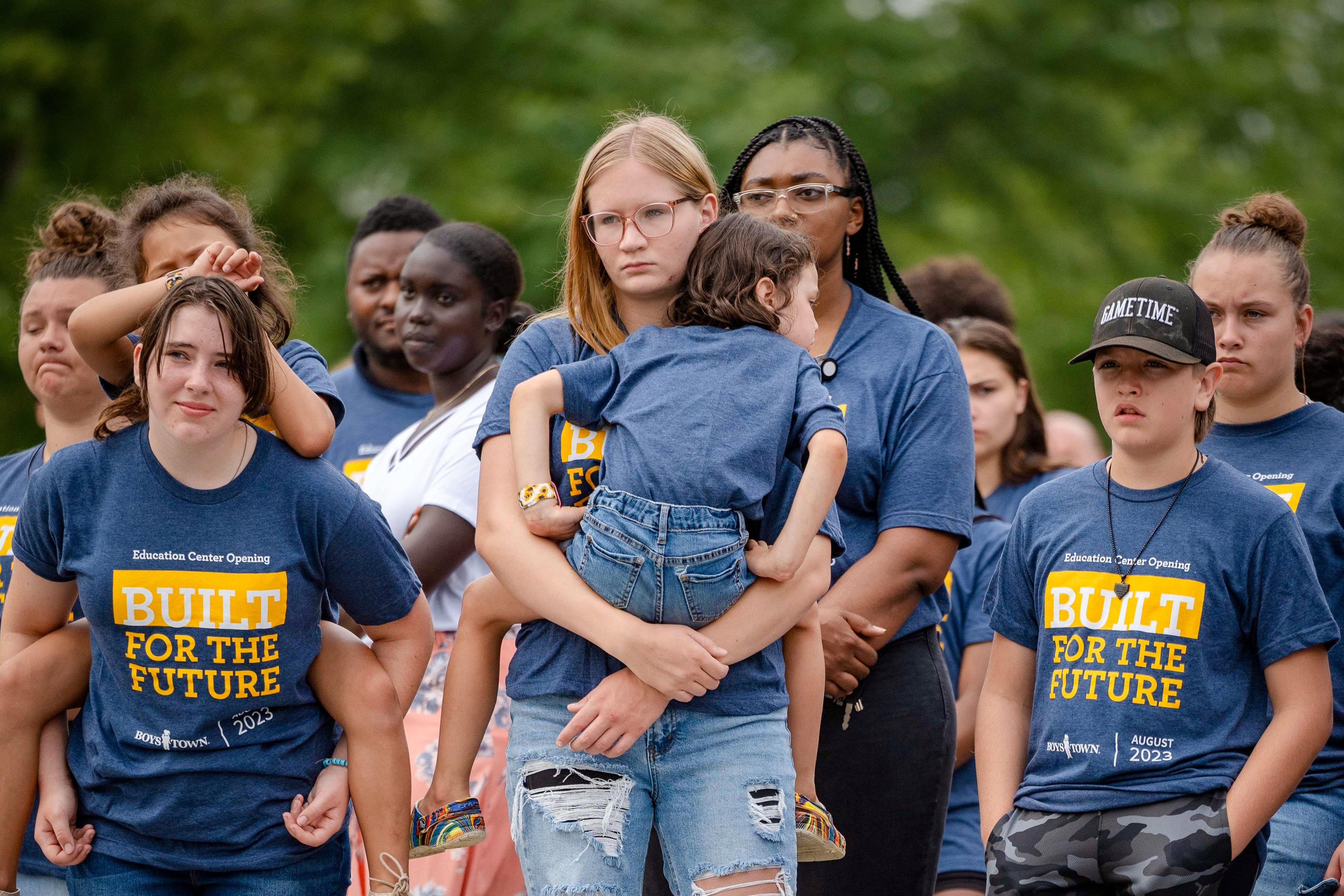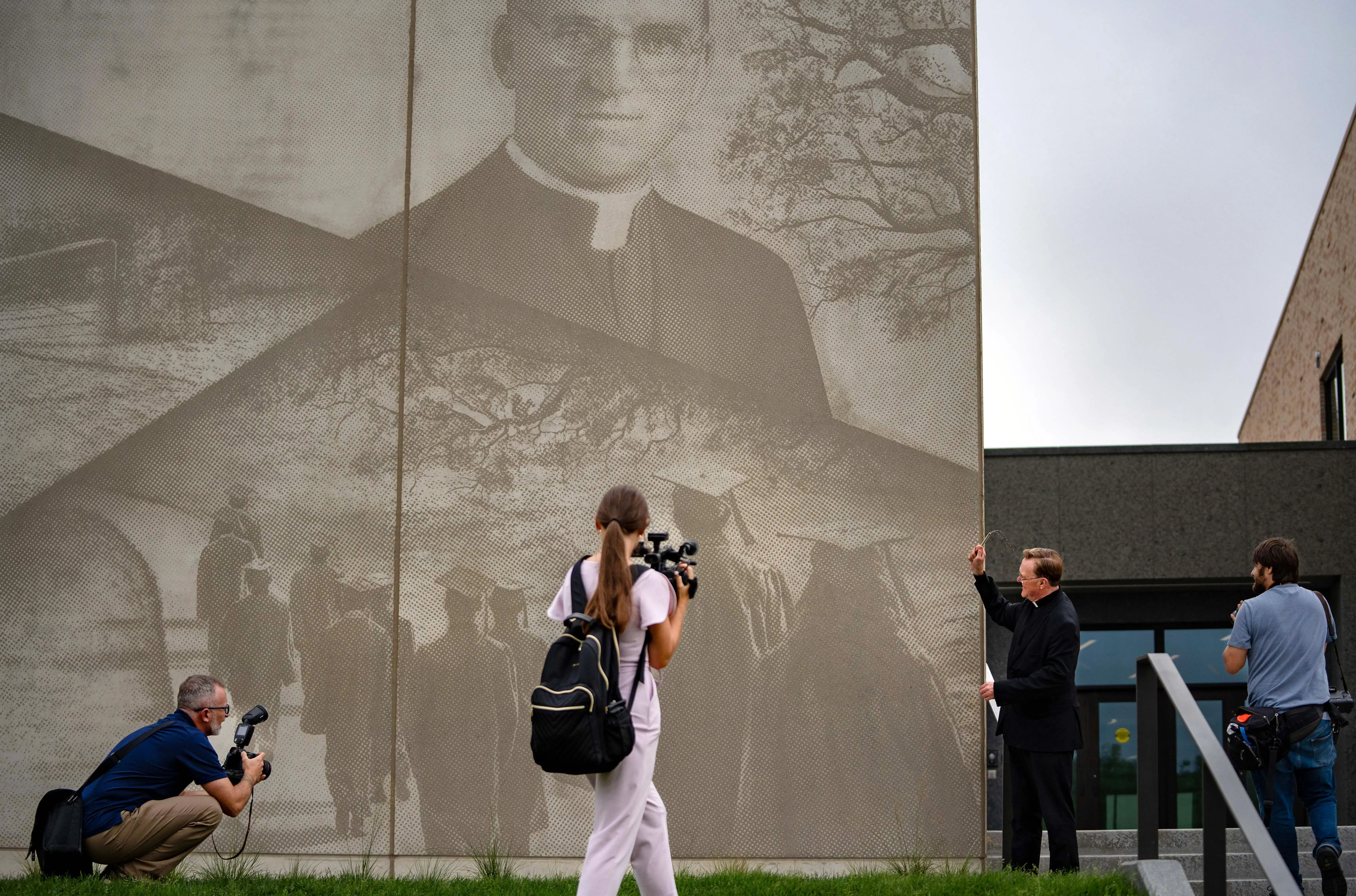
BOYS TOWN, Neb.—The Rev. Steven Boes told another heart-tugger just before he announced his retirement this summer, aimed at all the supporters and donors of Boys Town.
The longtime president, advocate and fundraiser-in-chief for the iconic youth home was marking the ribbon-cutting for a new $46.5 million school in the shadow of a mammoth concrete mural etched with the image of Msgr. Edward J. Flanagan, who founded Boys Town more than a century ago. Standing at the podium, Boes told the crowd he had overheard two kids talking at the building’s groundbreaking two years prior.
“I wonder why they’re doing all this for us?” Boes recalled one saying. “Why are they building us this new school?”
“I think it’s ‘cause they think we’re worth it,” the other replied.

As a nonprofit journalism organization, we depend on your support to fund more than 170 reporting projects every year on critical global and local issues. Donate any amount today to become a Pulitzer Center Champion and receive exclusive benefits!
It was a line that could have been written for the 1938 Oscar-winning movie that made a legend of Flanagan and his home for orphaned and wayward boys. Since then, Boys Town’s sentimental appeals for charity on behalf of the needy boys and, beginning in 1979, girls in its care have been as constant as its veneration for the Irish-born priest who in 2012 became a candidate for sainthood.
Direct mail solicitations, sponsored content on social media and other marketing have persuaded thousands of Americans to donate millions. The youths placed in the nonprofit’s historic home give moving testimonials. Touching Instagram reels show them graduating from high school. Letters coax recipients to help send the kids to their first summer camp at Lake Okoboji in neighboring Iowa. Boys Town promises that just a few dollars can change a child’s life and help fulfill Flanagan’s dream.
“When you donate to Boys Town,” it says in its promotional videos, “you are providing healing and hope for thousands of youth who go on to live happy, productive lives.”
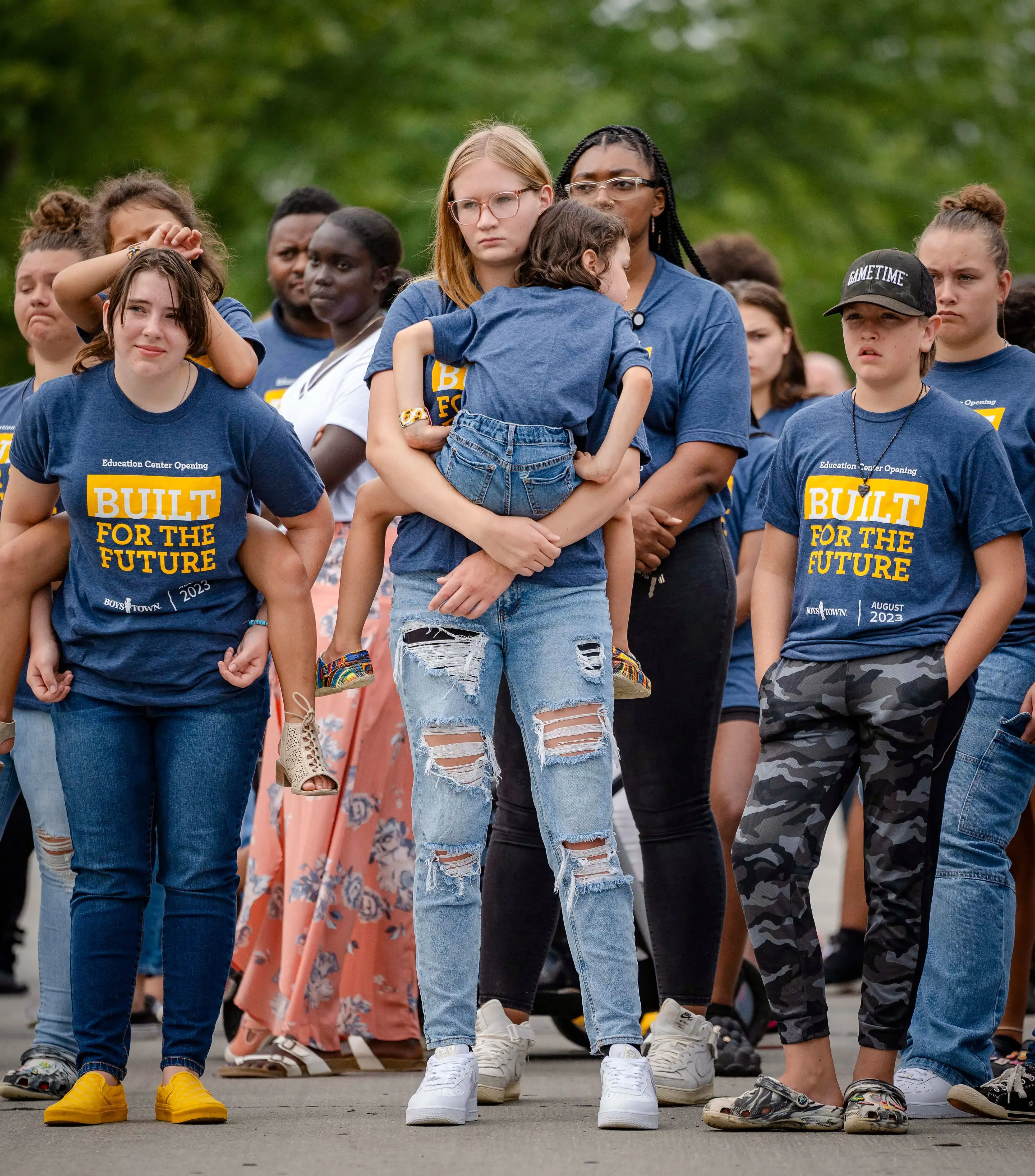
What supporters aren’t told: While Boys Town raises more each year in donations and bequests than 99% of America's 1.37 million public charities, it has provided a home for far fewer youths in the past five years than in decades past. And it provides relatively little specific financial assistance to the wider mix of children and families it serves, despite assets of $1.76 billion and substantial reserves. It also receives estimated tax breaks of $11 million annually for being a tax-exempt nonprofit, according to Berneta Haynes, a senior attorney and expert at the National Consumer Law Center.
Thanks to outsized spending on fundraising, returns on investments and the generosity of strangers, those who run Boys Town and its endowment today have the potential to assist more children in need than any other nonprofit youth home in the country, or the vast majority of youth charities in the U.S., according to data from its financial statements and Forbes’ top 100 charities list last year.
But the charity has kept its residential census numbers at less than half its licensed capacity amid historically high demand nationally for residential care, while plowing more and more money into fundraising on their behalf.
Boys Town CEO Rod Kempkes repeatedly declined the Des Moines Register's requests over three months to interview him about the spending on fundraising or any changes he foresees after a major change in the organization's leadership.
Since Flanagan’s death 75 years ago, the Archdiocese of Omaha has had a hand in choosing each of Boys Town’s national leaders, always a priest within its ranks who, as Boes did, helps oversee the home, acts as an advocate for needy children and the charity, leads its fundraising and serves as a spiritual leader.
Kempkes, a former chief operating officer at West Corp., a cloud-based technology company, joined Boys Town five years ago, bringing expertise in value creation and promises of transparency to foster a "strong sense of purpose and accountability within the organization."
Even as Boys Town expands other programming, Barb Vollmer, its executive vice president of youth care, said it is not backing away from youth care, the heart of Flanagan's mission and the entreaty to so many Americans who have given so much over its 106-year history.
Vollmer said that during its 18 years under Boes, Boys Town strategically expanded an array of preventive programs, including in-home family therapy and school-based programs, as demand for those services increased. Boys Town expects to serve more youth than ever this year ― around 28,000 ― with those programs, she said.

Amid the COVID-19 pandemic, workforce shortages and changes to federal funding for child welfare, Boys Town's residential programs served fewer kids, she acknowledged. But Vollmer says it plans to serve more this year ― about 700 total ― at its home campus in Nebraska and its smaller programs in Orlando and Tallahassee, Florida; New Orleans; and Portsmouth, Rhode Island. By year's end, a total of about 500 teens and adolescents will have been placed in about 50 family-style homes in Boys Town's home village, created by Flanagan, on the west side of Omaha, she said, and five more homes will open to placements next year.
Residential programs around the country have closed after investigations found abuse of children in their care or little evidence of educating them. Respected programs struggled, too, as experts and funders began questioning the benefits of long-term congregate care.
Still, Vollmer insisted, Boys Town remains as committed as ever to long-term residential care for the kids who need it, most staying for 18 or 19 months on average, regardless of their ability to pay.
"That's the beauty of the (endowment) fund, Father Flanagan's Fund for Needy Children," she said. "We have the ability to provide that charity care."
Boys Town devotes less than 1% of its spending to specific assistance to youth
Overall, Boys Town gets good marks from charity watchdogs for devoting most of its annual expenses to its programming, which is much broader today than it once was, spanning health care, education and human services, as well as youth care.
But while its fundraising appeals often focus on the youth at the Nebraska home and Father Flanagan, almost 45% of Boys Town’s expenses last year went to the nonprofit’s National Research Hospital. That hospital is largely supported by private insurance.
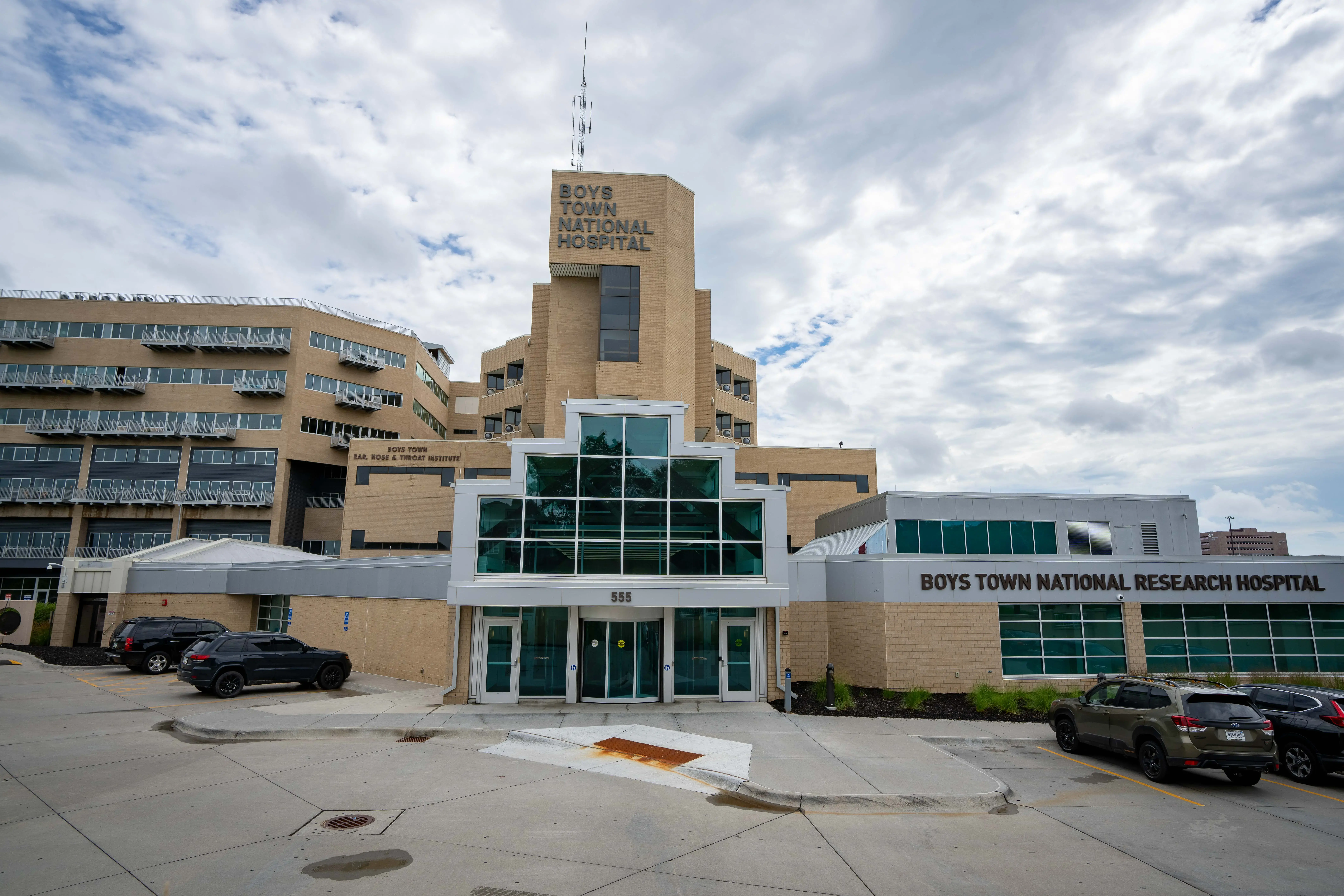
Only 13.5% of the expenses went to its programs in Nebraska and Iowa, which include the historic youth home as well as a wide mix of preventive programs in both states. About 12.7% went to its residential or preventive programs in other states.
Vollmer said in an October interview she wasn’t sure what Boys Town spends on financial assistance for youth in its residential programs, but called it a “big number.” She said ensuring “money isn’t the reason kids can’t get access to residential care” has always been part of Boys Town’s mission.
But Boys Town's consolidated financial statement shows that it spent under $4.5 million last year on specific assistance to youth, a measure of its own charity to the needy, throughout all of its diverse programs, including residential care. That was less than 1% of its annual expenses of $499 million.
That assistance included almost $2.9 million for kids in its Nebraska and Iowa programs.
Like many large charities, Boys Town touts stamps of approval from charity trackers such as the Better Business Bureau’s Wise Giving Alliance, GuideStar (now Candid) and Charity Navigator. Like others, it also has a separate endowment, which holds the bulk of its assets ― about $1.1 billion. Boys Town insiders run the endowment, Father Flanagan's Fund for Needy Children, which provides about $46 million to Boys Town annually, the organization's consolidated financial statement shows. The endowment isn't ranked or rated by the most of the organizations consumers use to make decisions about giving.
Boys Town's consolidated financial statement, which reflects finances and spending across all its programs and its endowment, shows it spent almost 14 times more on fundraising last year than on specific assistance to youth. The amount spent on fundraising was almost as much as the $67 million it spent on all its youth programming in Nebraska and Iowa, the Register found.
Last year, Boys Town spent $63 million to raise about $167 million in unrestricted contributions, legacies and bequests, or $38 for every $100 raised, much more per $100 than most of the nation's largest charities, its 2022 financial statement shows.
The result: Donors get less bang for their charitable buck.
“They haven’t been a very efficient fundraiser for years,” said Laurie Styron, executive director of CharityWatch, which has examined the finances and fundraising of Boys Town and its endowment, along with hundreds of other high-asset charities, since the 1990s.
Experts caution against comparing nonprofits' overhead costs, including fundraising, because they have different funding streams and different needs. But the cost to raise $100 is a common metric used to calculate fundraising efficiency. Organizations tally the figure slightly differently, but they all generally divide total fundraising expenses by revenue raised.
In its last analysis of high-asset charities in 2020, CharityWatch calculated Boys Town spent $45 for every $100 it pulled in, the worst ratio of any nonprofit with over $1 billion in assets it reviewed.
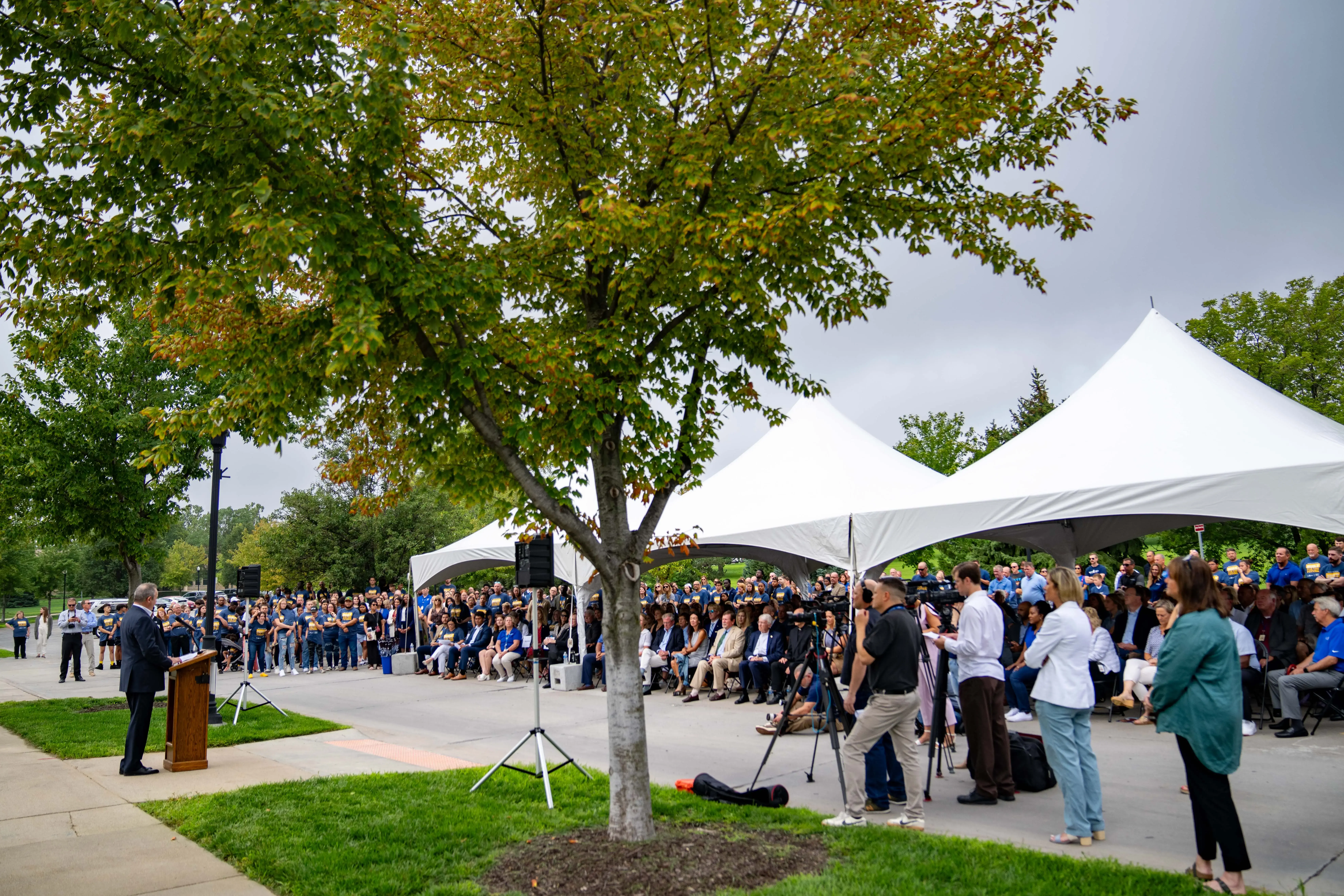
In that comparison, Boys Town spent a higher proportion of its revenue on fundraising than St. Jude Children’s Research Hospital, Shriners Hospital or the Cystic Fibrosis Foundation, some of the other highest-asset charities in the United States.
In Forbes’ rankings last December of the top 100 charities in the country by private donations, a list the magazine has maintained since 1999, it ranked Father Flanagan’s Boys Home, another name used by Boys Town, at the bottom for fundraising efficiency.
Boys Town fares better on another charitable organization performance measure: the portion of its annual revenue spent on services to fulfill its mission, with 83% of its expenses going to operations last year. Most highly efficient charities spend 75% or more on programming, charity watchdogs say.
Vollmer said during the October interview that Boys Town would provide a breakdown of assistance to youth in its residential programs, but it did not.
Boys Town stopped responding to the Register’s questions in mid-October when the newspaper again pushed for answers regarding its fundraising, charity care, compensation to company insiders and the criticism that it is not an efficient fundraiser.
While seeking handouts, Boys Town sits on riches

In 1917, Flanagan borrowed $90 to create a downtown boardinghouse for a handful of boys and eventually built a “City of Little Men” on an old farm site. It's a well-worn tale told again and again at Boys Town.
With the backing of the Omaha archdiocese, Flanagan endeavored to house hundreds of troubled, neglected and abandoned youth. But he constantly struggled with fundraising.
In the early, hardscrabble years, Flanagan wrote that he hoped his hand-to-mouth charity could one day create an endowment that would make it unnecessary “for us to spend a good portion of our time in the appeal and collection of funds,” according to Boys Town's 2022 annual report.
His fame grew as he campaigned against incarcerating juveniles, saying "no boy is really a bad boy," and sought to bring them to Boys Town instead for a new start in life. MetroGoldwyn-Mayer's 1938 movie “Boys Town,” starring Spencer Tracy and Mickey Rooney, and a 1941 sequel made the charity an international sensation, allowing its leaders to take the art of raising money to unprecedented levels.
In the early 1970s, after Boys Town's assets were made public for the first time, Monsignor Nicholas H. Wegner, the priest chosen by the Omaha archdiocese to succeed Flanagan after his death in 1948, suggested in the spirit of Flanagan's dream that Boys Town might end its fundraising if it further built up its endowment.
But as its leaders diversified its programs, Boys Town spent even more on fundraising, with timelessly salable appeals focusing on Flanagan's legacy and needy wards.
Today, Boys Town deploys more ways than ever to raise money. Visitors who stop to see the college-like home campus or go to its website are asked to give through multiple links, pop-ups and QR codes. It paid Facebook at least $1.2 million last year in marketing fees for sponsored content. Publications and postage for fundraising cost another $50 million, its tax returns show.
Support for Boys Town 'is always going to be there,' an Omaha neighbor says
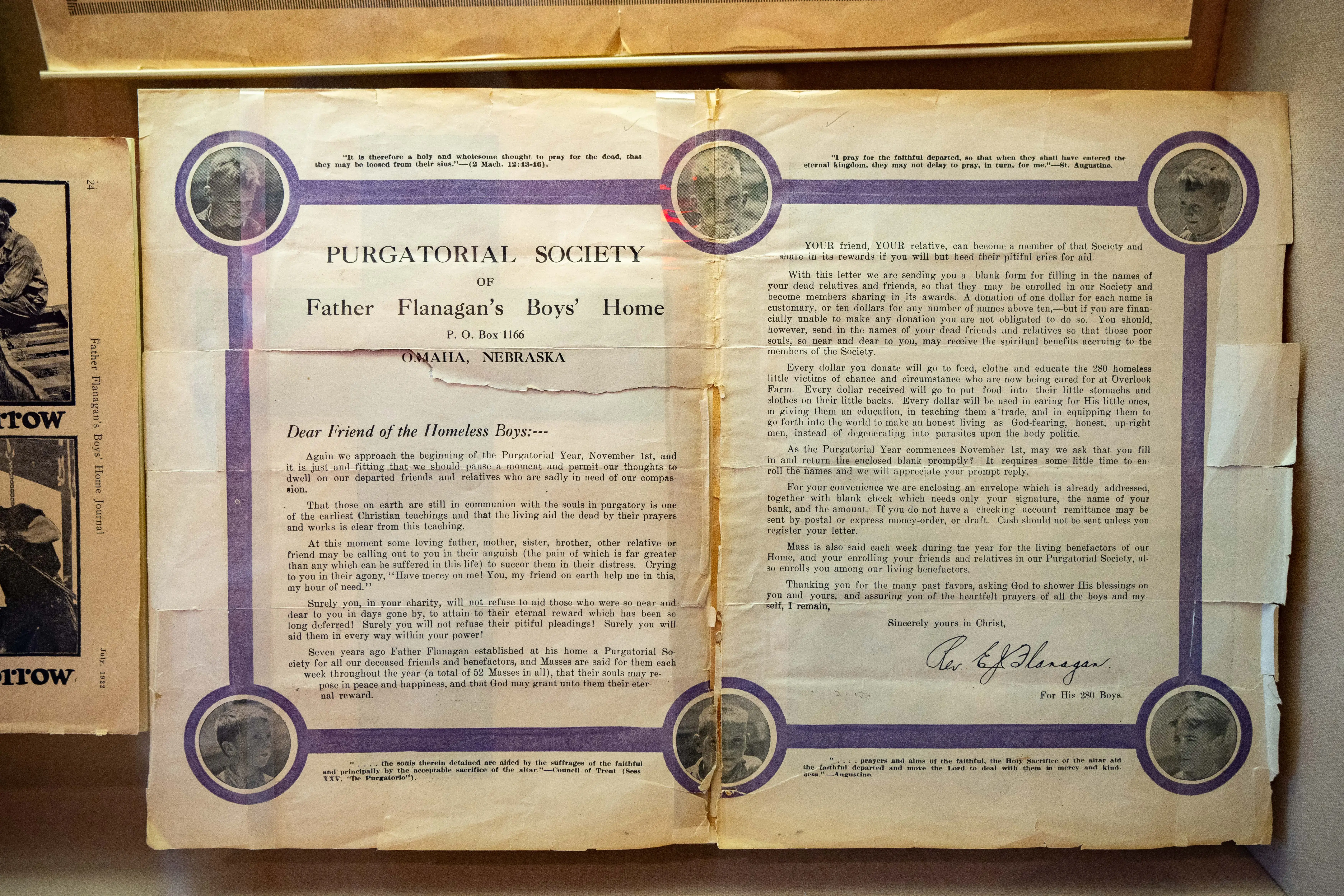
In Nebraska, where Boys Town is a major human services provider and one of the state's most iconic institutions, no shortage of local, state and federal political leaders sing its praises.
“It’s a community,” said state Sen. Tony Vargas, a Democrat running for Congress in Nebraska’s 2nd Congressional District who was one of six state legislators and other local politicians to attend the ribbon-cutting for the new school in August. “If it wasn’t for that community, you wouldn’t continue to see this model be successful.”
Omaha natives like 52-year-old Lillie Manuel, who grew up next to Boys Town, say it remains beloved because of the good work it has done for decades, protecting thousands of children who don’t have family support or who need second chances.
“It’s one of the biggest donor receivers in Nebraska,” Manuel said. “That money is always going to be there. Always.”
Outside the state, some who give to Boys Town readily admit they have little or no knowledge about it other than the idyllic depictions they see on social media.
Scrolling her Facebook feed, Diane Prigge of Provo, Utah, said she donates because she loves hearing the success stories and seeing the happy faces of the teens sent to a place she’s never been.
Prigge said she’s compelled to give part of her Social Security, all she lives on, a couple times a year because she remembers wishing she would have had a place like Boys Town to turn to when she was young. She also has a daughter who because of hard luck, she said, she was unable to raise.
“My heart just goes out to the place,” she said. “And at Christmastime, they send out the most beautiful Christmas cards I’ve ever seen.”
Boys Town serves fewer kids at Nebraska campus as it broadens its mission
The federal government has scaled back what it's willing to pay for foster kids in residential care.
With Congress' enactment of the Family First Prevention Services Act five years ago, new restrictions aim to push states to dramatically reduce their reliance on long-term congregate care facilities in favor of community-based programs and services closer to children's families.
Today, federal funds cover long-term residential treatment programs only if they treat acute health needs or if they are independent living programs for older teens transitioning out of foster care, for pregnant or parenting teens, or for youths at risk of sex trafficking.
In the past five years, fewer than 290 youths have been enrolled at Boys Town's private school on the west side of Omaha, Nebraska Department of Education statistics show. That's less than half the home's capacity of 600, according to state licensing records.
With an annual budget that is greater than the city of Omaha's, modern-day Boys Town is a much more diverse organization than the one Flanagan started. It markets a wide mix of health care, therapy, research and preventive programs more in keeping with changes in child welfare and education.
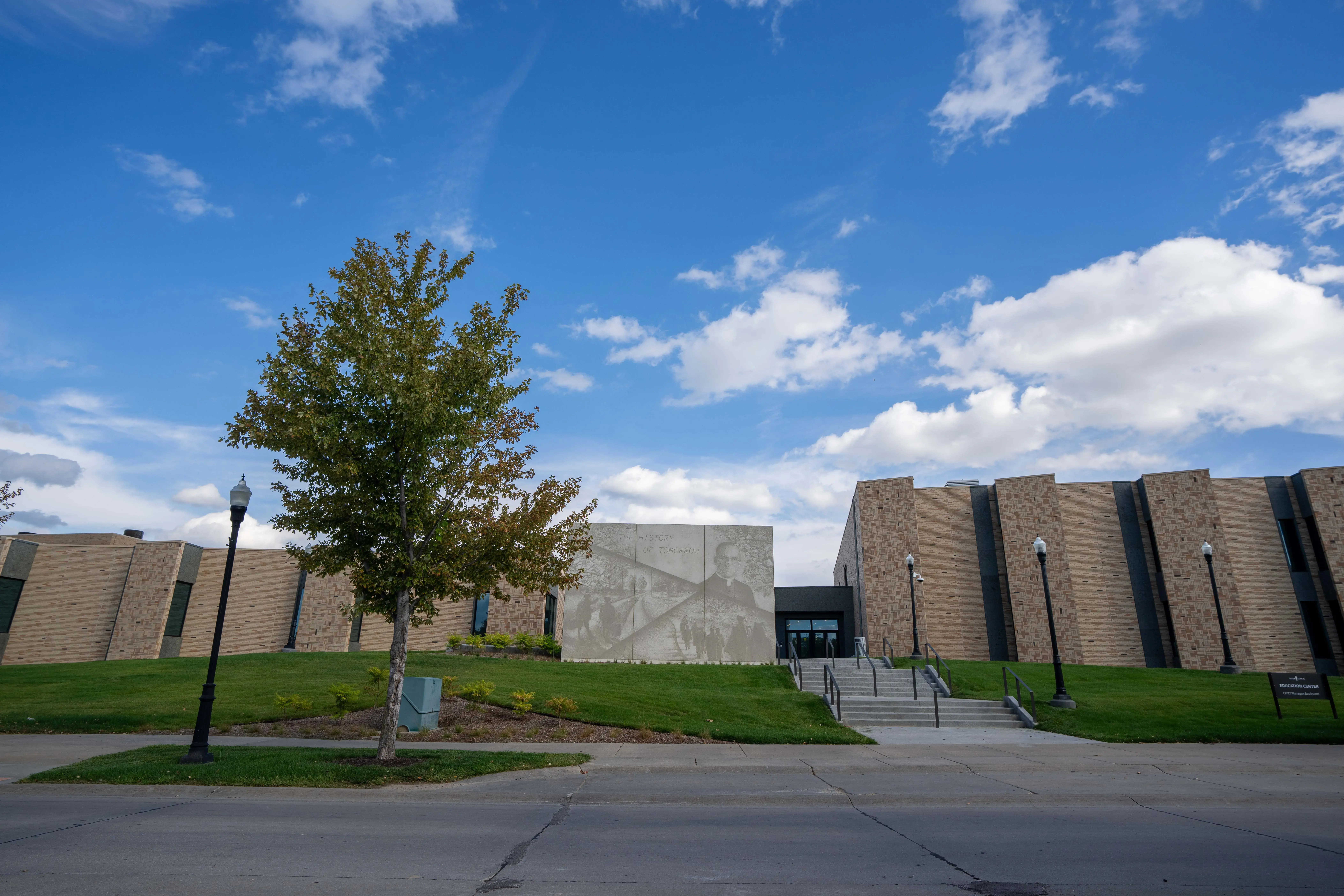
As states across the country, including Iowa, have run out of room in residential facilities to house abused and neglected children amid a shortage of community-based providers, Father Flanagan’s Boys Home, the Nebraska home campus, has continued to limit the number of boys and girls it accepts.
Today's population at Boys Town encompasses a mix of kids who have suffered abuse and neglect, offenders from the juvenile justice system, or others who need psychotropic medication or help with behavior problems. The home does not take kids who have developmental disabilities or those who need drug treatment.
Vollmer said Boys Town spends more than most programs would to ensure quality services for the children in its care. "We have allocations from the (endowment) fund to make sure we're operating at a high level," she said.
Unlike at other programs, youths live in family settings with trained house parents, experience typical youth activities like school sports or summer camp, and learn social, academic and decision-making skills aimed at helping them be more successful.
Most youths return home before they would graduate from Boys Town's high school, but everyone who stays graduates, Vollmer said.
Children's chances of staying in school are higher ― about 84% ― if they go through Boys Town's programming than if they're in the foster care system, where the graduation rate is more like 50%, Vollmer said.
Outcomes have varied in different studies; the 50% graduation rate comes from an oft-cited 2011 longitudinal study on the adult functioning of former foster youth conducted by the University of Chicago.
Do Boys Town's fundraising appeals align with its broader mission?

When the ribbon was cut in August on Boys Town’s new school and Boes splashed holy water from Ireland on the three-story, 110,000-square-foot building, the organization was still soliciting donations for the building. In September, it said on its website that it was still $5 million short of its $30 million fundraising goal.
At least 6,400 donors from all 50 states already had chipped in more than $25 million to the cause, the website says.
Boys Town, which used its own municipal bonding authority for the project, also received $10 million in federal American Rescue Plan Act funds from the state and $125,000 from Douglas County.
Questions from nonprofit watchdogs, journalists and philanthropy experts about Boys Town's spending on fundraising and the amount it has held in reserves are not new.
In 1994, Father Flanagan's Boys Home sued the American Institute of Philanthropy, the organization that became CharityWatch, for giving it an “F” rating for stockpiling assets ― then more than $500 million ― that far exceeded its expenses.
The institute called it one of the nation’s "least needy charities"; the lawsuit alleged the low grade defamed Boys Town and damaged its fundraising ability.
At the time, the institute said Boys Town had enough money in the bank to finance its operations for 5.9 years. Today, it holds enough to fund operations for about 3.6 years, still a substantial amount, according to nonprofit experts. The lawsuit ended in a private settlement.
"If they are giving donors the impression that most of their donations are going to a specific program, say, housing children, but then they are spending most funds on other programs, that’s an example of their marketing materials not aligning with what their finances reveal."
— Laurie Styron, executive director of CharityWatch
Nonprofit experts say the growing number of nonprofit spinoff organizations, including endowments, are making it more difficult for donors to get a clear picture of organizations' finances and whether their spending remains true to their charitable cause.
"If the one goal we have is transparency for the donor … you should know how this organization spends its money," said Beth Gazley, a professor of public affairs at Indiana University and affiliate faculty member at the Lilly Family School of Philanthropy. "When they spin off related organizations… I think that becomes more problematic for the average donor."
In an era when Americans know more youth are troubled and residential facilities across the country have been closing, Styron of CharityWatch questioned the ethics of Boys Town focusing so much of its donor marketing on the relatively few needy wards it serves today.
“If they are giving donors the impression that most of their donations are going to a specific program, say, housing children, but then they are spending most funds on other programs, that’s an example of their marketing materials not aligning with what their finances reveal,” she said.


